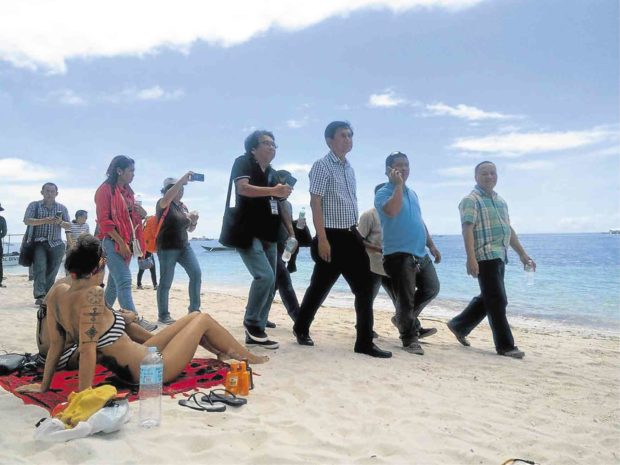
BEACH INSPECTION Environment Secretary Roy Cimatu inspects Panglao’s hotels, resorts and other tourism-oriented establishments as the government continues its crackdown on environmental violators. —LEO UDTOHAN
PANGLAO, BOHOL—Despite Environment Secretary Roy Cimatu’s warnings that he would close establishments violating environmental laws, illegal structures have remained on Panglao Island’s coastline’s easement zone in Bohol province.
None of the establishments along the Alona shoreline in Panglao that violated the 20-meter easement rule had started to demolish structures erected along the no-build zone, almost one month after Cimatu inspected the area.
The secretary had given the owners six months to demolish the structures.
Resort owner Dolereich Dumaluan, vice president of Panglao Island Chamber of Commerce and Industry Inc. (PICCI), said that some resort operators were set to ask Cimatu to reconsider his easement compliance order.
Dumaluan said the stakeholders would instead propose to Cimatu to focus on the rehabilitation of the beach to widen the shoreline.
But Mayette Sarabia-Gasatan, also a vice president of PICCI, said illegal structures should be demolished.
“Of course, we have to follow the law because we don’t want to become like Boracay,” Gasatan said.
Last month, Cimatu inspected the Alona Beach shoreline at Barangay Tawala to check the establishments’ compliance with environmental laws.
Panglao Island, considered the crown jewel of Bohol tourism, is composed of the towns of Panglao and Dauis.
Despite the impending closure of Boracay and closure threats to other top tourist destinations in the region, tourists visiting Central Visayas continue to increase due to more flights, improved infrastructure, and aggressive social media campaign, according to the Department of Tourism (DOT).
Statistics released by the DOT head office in Makati City said domestic travelers dominated the arrival volume with around 4 million visiting the region’s four provinces, namely, Cebu, Bohol, Negros Oriental and Siquijor, the DOT said.
For foreign visitors, the regional office said most came from South Korea, with 895,776 travelers, followed by China, Japan and the United States.